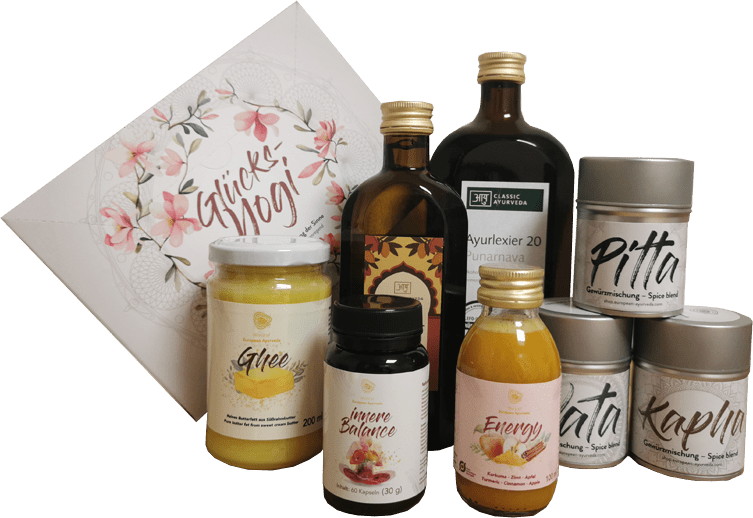Do you know someone who always attracts attention? Someone who is bursting with charisma and fills a room with their mere presence? This person is probably a Pitta type. According to Ayurvedic teachings, they are particularly engaging, self-confident and determined. Perhaps you recognise yourself in this description. If you want to know exactly, take a look at our digital dosha test.
Now some are probably wondering: Dosha types, what does that mean? Before we take a closer look at Pitta, let's take a step back and see what the Ayurvedic types are all about. These can provide all kinds of information about diet and lifestyle.
What are Ayurvedic types?
In Ayurveda (the 'knowledge of life') it is believed that there are three main 'fault potentials': The so-called Doshas. They are present from person to person in different proportions and depending on which potential predominates (or which potentials), this shapes character and personality.
For example, if most of the Pitta potential is present, one tends to be self-confident, determined and resilient. An imbalance, i.e. too much or too little of this potential, can lead to various impairments (more on this in a moment). Those who are already naturally inclined to this type are also more at risk for imbalances in this area.
However, this does not mean that the other doshas, Vata and Kapha, are not also present. They can even have a balancing and complementary effect and ultimately make up the exact constellation of each person.
Tendencies of the Pitta type
People whose Pitta is pronounced can be recognised, among other things, by their medium stature. Their self-confident, strong mental attitude affects their straight, almost proud posture. They are intelligent, perceptive and love challenges. You like to prove your ability, which you seldom doubt, even in direct competition with others if necessary.

The Pitta potential is associated with the element fire, which in turn is related to the digestive tract, among other things. It works particularly efficiently, which means that Pitta types get hungry at shorter intervals than Kapha types. If this is the case, the mood can sometimes change into impatience and irritability.
When Pitta-influenced people start something, they start it right. They are bursting with power, motivation and ambition and want to satisfy their perfectionism at all costs. What is immediately noticeable when dealing with them is their eloquence, their strong charisma, their dynamism and their charisma. Unfortunately, this impression is not always so positive, because those who work with them are sometimes quickly shown their own gaps in competence.
When Pitta is imbalanced
If the Pitta level rises to excess , aggression, choleric fits, fanaticism and intolerance can occur more frequently. These people are then not satisfied with anything and overshoot the target. Too much conviction about oneself, even to the point of narcissism, harms both the person and his or her balance, as well as the people around him or her.
In some cases, Pitta types would go over the proverbial dead bodies to get their ideas accepted. This may then bring them to the point of harming people around them, but it is not impossible.
On a physical level, pitta excess is noticeable through impure skin, stomach pain, heartburn, diarrhoea and inflammation. This is all caused by excessive acidity, which only adds fuel to the fire of the Pitta types. Fortunately, this can be counteracted through diet and new behavioural patterns.
Which foods for imbalances?
Basically, Pitta types should eat a cool, dry, strengthening, sweet, bitter and astringent diet. This balances the fire energy that characterises this type. This definitely curbs an excess of pitta dosha.
Conversely, if there is too little of it, you can turn to more acidic foods: Meat, white flour, coffee, sugar, spicy foods, citrus fruits, dairy products, vinegar. However, people who would rather belong to the Pitta type should naturally avoid these foods. Alcohol would also be taboo.
A to-eat list, so to speak, includes cooling foods and spices such as melons, potatoes, fennel, cardamom, mint, coriander and parsnips. Crisp steamed vegetables, fresh salads, raw vegetables, grapes and green vegetables such as asparagus, broccoli, Brussels sprouts, okra pods, peas, celery, green beans, peppers and courgettes are also recommended for pitta excess. They practically calm the fire and bring it back to a healthy level.
You can also make sure to eat regularly. Unlike Kapha types, Pitta types can also eat small meals more than three times a day. Due to the rather faster digestion, this is no problem at all for such organisms. However, these meals should be rich and nutritious.
What you can keep in mind in everyday life
As a Pitta type, you must not get bored. Always look for new mental and physical challenges and do sports. And why not perhaps a sport that is played in competitions? This way you can satisfy your desire for challenge and recognition. Physical activity also helps to get rid of aggression, anger and resentment so that these emotions do not explode when others might be harmed.
Try to use your potential, intelligence and perseverance for the good of all and to reduce the need for control and perfection to a healthy level. Practise contentment, helpfulness, tolerance and serenity, sometimes purposefully.
What else do you do to cope well with everyday life as a Pitta type? At the end of the page you can leave us a leave us acomment.





